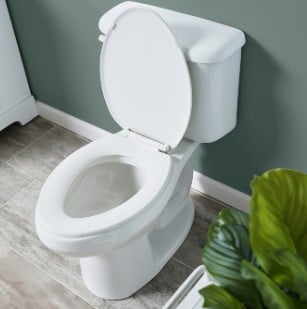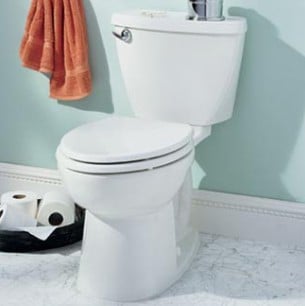7 American Standard Toilet Flushing Problems Fixed!
You can rely on American Standard toilets for comfort, durability, cutting-edge toilet technologies, water-saving flushes, and powerful cleaning. However, despite being high-performing, American Standard toilet flushing problems can be a nuisance.
Common American Standard toilet flushing problems include ghost flushing, sluggish flush, clogged inlet holes, broken lift chains, and faulty flappers. Moreover, they can exhibit poor toilet drain pipe design and Low water levels in the tanks.
Fortunately, you can correct most of these issues yourself, provided you have the know-how. This post thoroughly examines the possible causes of American Standard toilet flushing problems and the recommended fixes.

American Standard Toilet Flushing Problems (Quick Fix)
The table below summarizes the problems you could face with American Standard flushing and how to fix them.
| Problem | Possible Cause | Recommended Fix | |
| 1. | Ghost flushing | A faulty flush valve assembly Defective gasket Loose flapper Lack of a watertight seal | Replace the valve assembly Tighten the flapper Create a watertight seal |
| 2. | Weak/sluggish flush | Unflushed toilet paper Corrosion debris | Plunge the toilet |
| 3. | Clogged inlet holes | Mineral deposits in the holes Bacteria | Remove mineral deposits and bacteria Use water softeners |
| 4. | Broken lift chain | Over tightening the chain | Replace the broken chain |
| 5. | Low water levels in the tank | Components in the tank inhibit refilling | Turn the float adjustment screw clockwise |
| 6. | Faulty flapper | Damaged or old flapper | Replace the flapper |
| 7. | Poor toilet drain pipe design | Pipe lacking a downward slope | Contact a plumber |
1. Ghost Flushing
Even though American Standard toilets (View on Amazon) are WaterSense certified, they can occasionally have issues that force you to dig deeper into your wallet to cover increased water bills. One problem that can cause that is ghost flushing.
Ghost flushing occurs when you hear your toilet flush without human intervention, with the problem stemming from water leaking into the toilet bowl. This happens if the tank flapper fails to create a watertight seal.
If this stays unattended, more water will leak through the flapper, forcing the float arm to drop and activate the fill valve. The fill valve then triggers tank refilling, which can be mistaken for flushing.
Cleaning the flapper with chemicals like discs and pucks would truncate its lifespan and weaken the seal meant to stop water leakage. Additionally, defective gaskets and faulty flush valve assemblies are other potential culprits of ghost flushing.
Fix
- Cut off the water supply near the bottom of the toilet.
- Flush the toilet while holding the handle down. Do this until all the water drains from the tank.
- Next, disconnect the chain from your toilet handle, then separate it from the two posts on the flush valve assembly.
- Remove the flapper and install a new one on the two posts.
- Attach the flapper chain, ensuring it has the right slack to let the flapper seat correctly.
- Restore the water supply valve and allow the toilet tank to fill.
- Test the efficacy of the procedure by flushing your toilet.
- Check that the flapper seals properly by adding drops of food coloring in the tank and allow 20 minutes to see what happens. If the water in the bowl stays colorless, you’ve set a watertight seal.
2. Weak/Sluggish Flush
Toilet experts recommend 20-80 psi for your toilet to deliver reliable flushing performances. Anything below this range will cause your American Standard toilet to have sluggish flushes.
Toilet paper and other foreign materials can block the pipes. Even though they will not cause instant obstruction, they will considerably lower the toilet flushing power.
Slow flushing would not flush all waste down the drain. Consequently, these materials will build up with time, weakening the flushing power further and even clogging the drainage system.
Besides that, weak flushing happens when corrosion debris access the pipe walls.
Fix
- Use a plunger to plunge the toilet for 10-20 seconds.
- Clean the bowl by flushing the toilet.
- Repeat the above procedure two or three times to get the desired results.
- If corrosion debris is causing the sluggish flush, boil some water and pour it into the toilet bowl. Flush your toilet after a few minutes.
- If this does not work, use an auger snake to clear the clog; otherwise, get help from a certified plumber.

3. Broken Lift Chain
The lift chain enables the flapper to sit and pulls it up when you flush the fixture. With time, the chain may become loose or break because of excessive tension.
It stops the flapper from opening, hence impeding regular flushing.
Fix
- Remove the tank cover and place it aside.
- Cut off the water supply to your toilet.
- Turn the knob at the backside of the toilet clockwise to tighten it.
- Drain water from the toilet tank by flushing it. It causes the flush lever to pull the chain, which in turn lifts the flapper valve.
- Hand-lift the valve with the broken chain.
- Replace the broken and attach the new one to the flush lever bar.
- Slide the chain onto the metal clip and tighten it using needle-nose pliers.
- Fix the broken connections across the chain.
- Slide the two middle sections back together and re-bend the links with needle-nose pliers.
- Slip the metal ring into the opening atop the flapper valve.
- Using needle-nose pliers, fasten the remaining chain link to the uncovered ring.
- Install the metal clip at the end of the flush lever bar after threading the other end of the chain through it.
- Adjust the clip to attain the correct chain length.
- Rotate the knob at the back of the toilet anticlockwise to restore the water supply, then replace the toilet tank cover.
4. Low Water Levels In The Toilet Tank
American Standard toilets come with tanks with marks showing where the water level should reach. The level of water level should be one inch under the overflow tube.
Your toilet will experience flushing problems when the refilled water fails to reach the mark; this reduces your unit’s flushing power.
Moreover, having water below the water level indicator will close the flush valve partly, causing partial flushes. Besides low water levels, your toilet tank could harbor elements that prevent it from refilling.
Fix
- First, check the water level in your toilet.
- Ensure the water reaches the water level indicator in the tank (or set it one inch below the overflow tube). You can verify with the manual that came with the unit.
- Turn on the flush valve, then flush the toilet bowl.
- Adjust the rubber ball float by bending the handle upwards (slightly).
- Move the metal clip of the intake assembly upwards.
- You can also turn the float adjustment screw clockwise to raise the water level.
5. Clogged Inlet Holes
If you live in a neighborhood with hard water, your toilet could be susceptible to the accumulation of bacteria and mineral deposits. They clog the inlet holes, causing less water to get into the bowl and ultimately disabling flushing operations.
Fix
- Cut off the water supply and flush the toilet to drain the tank.
- Use Lime-A-Way or vinegar to clean the open valve.
- If you use white vinegar, measure 10-12 ounces and heat it to 49 degrees.
- Next, get a funnel and pour the vinegar into the overflow tube.
- Stay away from the toilet for a few hours to allow the vinegar to work on the mineral deposits.
- Turn the valve back on to ensure you have a normal water flow.
- Flush the toilet. If this does not clear the clog, use an Allen wrench to remove lingering mineral deposits.
- After clearing the mineral residues, consider using water softeners to limit the effects of hard water.
6. Poor Toilet Drain Pipe Design
How you install a toilet drain pipe will determine how your toilet flushes. Professionals recommend downward-sloping drain pipes for wastewater to get into the bowl, the pipes, and then the sewer line.
Anything contrary will pool water in the pipes and create an obstruction. It will trigger flushing problems because water from the bowl will not bypass the impediment.
Fix
Get certified plumbers to redesign the drain pipe.

7. Faulty Flapper
The flapper is the rubber seal covering the hole in the toilet tank. It allows water to flow down the bowl to facilitate flushing and refilling.
When the flapper is old, damaged, or warped, it will not close the hole in the tank to allow flushing and refilling. In addition, the incorrect flapper chain length will cause leaking and reduce the water available for flushing.
Fix
- Adjust the length of the flapper chain, making sure it is 1/2 an inch slack.
- Replace the old and damaged flapper.
- Contact a plumber in case of uncertainty.
What Is The Cause of My American Standard Toilet’s Improper Flushing?
You can trace improper flushing to problems with the flapper, clogged drain, and low water levels in the tank.
Final Remarks on American Standard Toilet Flushing Problems
American Standard is a household name in toilet manufacturing, touted for excellent fixtures. However, its toilets could suffer flushing problems like ghost flushing, weak flushing, low water levels, and more.
Refer to the post to diagnose and fix American Standard flushing problems.
Related posts:
Let Us Know How We’re Doing!
Did this expertly prepared resource answer your question?
Do you have another question about home maintenance, home improvement projects, home appliance repair, or something else?
Get more information, send in questions and keep the discussion going by contacting the I’ll Just Fix It Myself company customer service team at at 1-800-928-1490 or Email us at [email protected]
